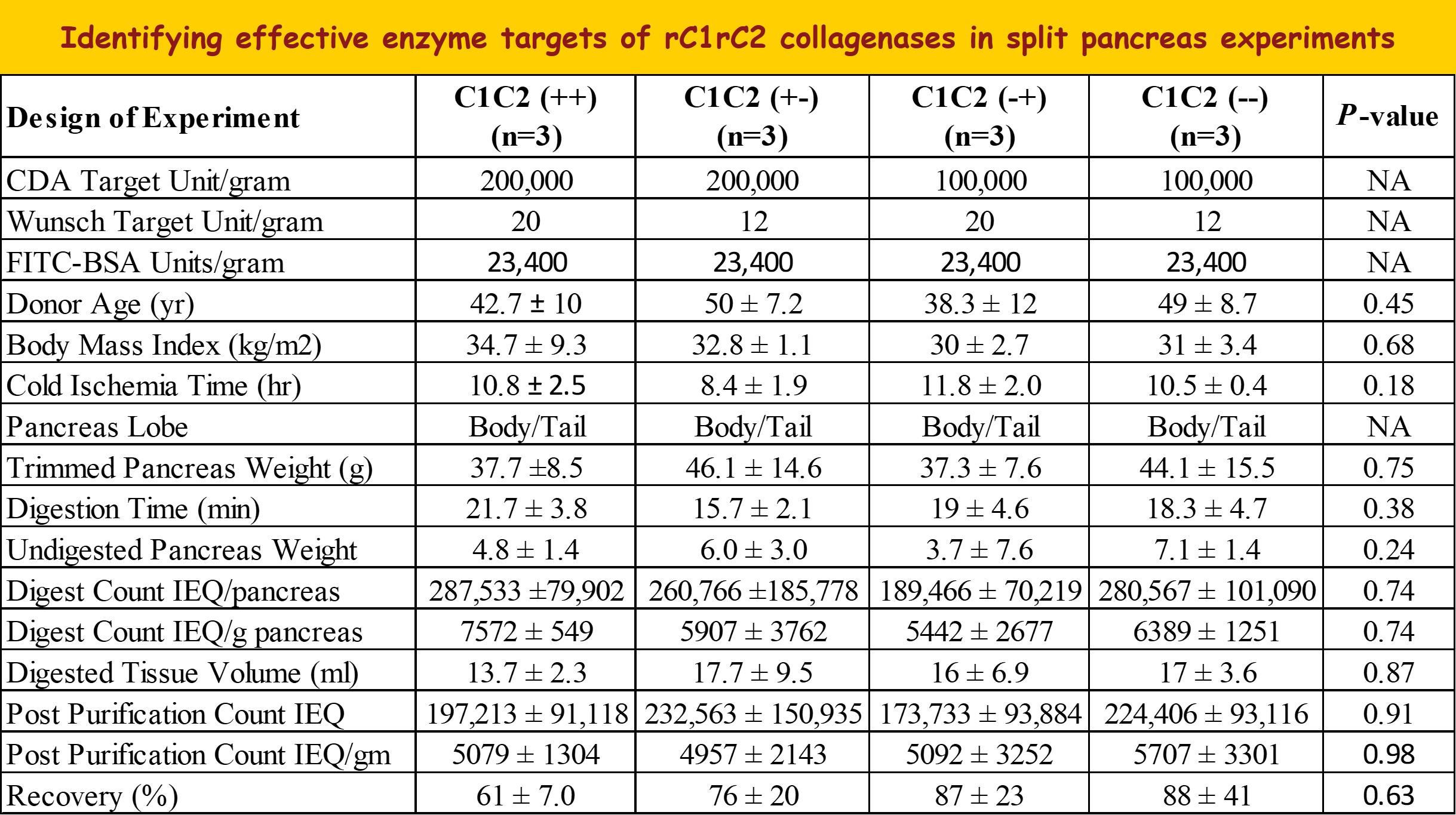Dosing rC1 and rC2 collagenases based on percent parenchymal mass improves digestion efficacy of fibrotic chronic pancreatitis pancreases intended for pediatric islet auto-transplantation
Krishna K. Samaga1, Ahad A. Kodipad1, Chandrashekar B. Revanna1, Siddharth Narayanan1, Jaimie D. Nathan1, Appakalai N. Balamurugan1.
1Pediatrics and Surgery, Center for Clinical and Translational Research, Nationwide Children's Hospital / Ohio State University, Columbus, OH, United States
Introduction: Primary objective was to utilize recombinant collagenases (rC1rC2) based on percent parenchymal mass for effective digestion of chronic pancreatitis pancreas to release islets followed by pediatric islet cell auto-transplantation. The dose and composition of the collagenase enzyme blends (CEB) used in the islet isolation process is a critical factor that impacts the number and quality of islets released from chronic pancreatitis pancreases (CPP). In this study, recombinant Clostridium histolyticum class I (rC1) and class II (rC2) collagenase on human pancreas digestion efficacy in combination with P. polymyxa protease (BP-protease) enzyme blend (rCEB) was assessed.
Methods: No animal components were used in the generation of the raw material or purification of rC1, rC2, or BP-Protease. In our initial studies, we tested rCEB in 22 human research pancreases utilizing split lobe and full lobe models. In the current study, we introduced rCEB for clinical islet auto-transplantation (n=5) we also tested this enzyme blend in two validation islet isolations (n=2) before introduced in clinical. The unit of collagenase used was >19 Wunsch units/gram pancreas (20- 40 unit) and >14.000 protease unit/gram pancreas (15,000-53,000 unit). Dosing of rCEB was done based on the assessment of percent parenchymal tissue mass in each chronic pancreatitis pancreas. Human islets were isolated according to our standard clinical islet isolation protocol. rCEB enzyme blend was injected into the pancreatic duct and digestion was done in Ricordi chamber. Pancreas digestion profiles (islet number, IEQ, islet/acinar morphology, tissue pellet volume, undigested pancreas) were carefully monitored and compared to isolations performed with traditional enzyme formulations.
Results: The rCEB efficacy and ratios were identified followed by islet functions were carefully monitored before introduced to clinical islet auto-transplantation.  Assessing percent parenchymal mass by visual and histology methods guided us to select the correct enzyme dosing. The digestion efficacy of rCEB in all five isolations were >90%, the undigested portion of pancreases were <10%. The pancreas digestion profiles were normal, and the final islet viability was >70% in all preparations. The final islet per gram pancreas was comparable to our previous islet isolation performed with traditional collagenase enzyme blends.
Assessing percent parenchymal mass by visual and histology methods guided us to select the correct enzyme dosing. The digestion efficacy of rCEB in all five isolations were >90%, the undigested portion of pancreases were <10%. The pancreas digestion profiles were normal, and the final islet viability was >70% in all preparations. The final islet per gram pancreas was comparable to our previous islet isolation performed with traditional collagenase enzyme blends.
Conclusions: Dosing rCEB based on percent parenchymal mass successfully digested the entire fibrotic pancreas and released all islets. Purified P. polymyxa protease in combination with rC1rC2 collagenases can be effectively applied to digest fibrotic chronic pancreatitis pancreases for maximizing islet yield intended for clinical islet auto-transplantation.